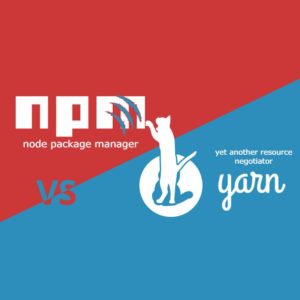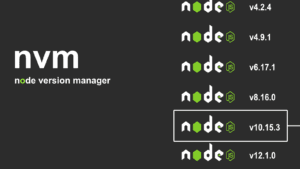Bower and NPM are two package managers that have had a profound impact on the development world. Both have revolutionized the way package managers work, so it is important to know the benefits that each has to offer and understand the core differences between Bower vs NPM.
Package Managers: What Do They Do?
A package manager consists of a bunch of software tools that are used to install, upgrade, configure, and remove software from a computer’s operating system. The task of a good package manager is to greatly simplify the aforementioned processes, as well as to provide an added layer of security. Package managers work by employing functions to ensure:
- The integrity of packages to be installed: This is crucial since it ensures that the packages that are being installed are accurate and have not been corrupted during the transmission process.
- Automatic installation and updating: This is particularly important for larger enterprises, since their operating system may consist of thousands of packages. In this situation, having to update and install manually would be a massive burden, and leaving the task to an efficient package manager frees up a lot of time and energy for more important tasks.
- Managing dependencies: When installing a library, it is often the case that the library, in turn, makes use of other libraries. Therefore, for the library to work, other libraries must be installed as well. Package managers take care of this and also help to avoid the dread-inducing “dependency hell.”
- Grouping packages based on function: When many different packages all provide a similar function, it is helpful to consolidate them accordingly. Package managers help with this.
Given this list, it is easy to see why package managers are essential for people working in web development and programming.
Bower
Bower was released in 2012, as a result of the Twitter open-source effort. It was designed in particular for front-end development, that is, the development of the user-interface aspect of a program. Find out what is Bower.
The name “Bower” is appropriate for a package manager, especially coming from Twitter. It is derived from a type of bird, called a bowerbird, of which the males make an elaborate structure known as a bower, constructed out of twigs and colored objects, to court female birds. As it says on the Bower website, “Bower does just that. Bower brings together bits and pieces from across the forest so you can build your structure.”
One of the great perks of Bower is that it has a flat dependency graph. This means if there are multiple packages that all depend on another package, then the latter package is installed only once. The benefit of the flat dependency graph is that it greatly reduces page load times, making interface navigation smoother.
NPM
NPM is the package manager for Node.js, a JavaScript runtime environment. In contrast to Bower, NPM was primarily used for back-end development–that is, the development of the underlying functionality of a program–in contrast to the front-end. NPM was created in 2010 by Isaac Z. Schlueter.
Bower: Pros and Cons
The main advantage of Bower was (until other package managers followed suit) its flat dependency graph, which makes it very efficient when it comes to user interface smoothness. This was one of the great advantages that it had over NPM initially: the latter did not have a flat dependency graph. In Bower, only one version would be installed of a dependency shared by multiple other dependencies. In NPM, multiple versions of the same dependency would be installed, causing unnecessary bloat and thus slowing things down.
Disadvantages of Bower
Since more package managers have improved their functionality, Bower is becoming obsolete, as its original perks are now provided by other package managers. The list of disadvantages now seems to outweigh the advantages of Bower:
- The flat dependency graph is offered by other package managers. Whereas the flat dependency graph is what made Bower stand out initially over other package managers like NPM, the latter now offers a flat dependency graph. Therefore Bower is redundant, especially since Bower requires NPM to run in the first place. Another package manager that offers a flat dependency graph is Yarn. Therefore Bower’s originally distinguishing feature is no longer a differentiator.
- The process of dependency management was left to the user. The same thing that helped Bower stand out over other package managers came at a price. Although NPM would often install multiple versions of the same dependency, it installed these dependencies independently of the user’s command. Installation of a package was quick and easy since the user didn’t have to keep track of all the other dependencies. Bower did not provide this functionality, and therefore users had to define which packages used which dependencies. Thus what Bower offered as an advantage came at the price of ease of use.
- Bower is for front-end only. As stated in the first point, Bower requires NPM to run in the first place, so adding another package manager on top of a package manager is cumbersome. Furthermore, the clean-cut distinction between NPM for the back-end and Bower for the front-end can just as easily be done with NPM alone: for example, just create two repositories.
- Bower has been deprecated. Since Bower has been deprecated by its creators, there is now little reason to use it. It is still being maintained for those who still use it. However, it is not recommended given the rise of other package managers like NPM.
NPM: Pros and Cons
As a Bower replacement, NPM offers multiple benefits:
- It has a larger repository. NPM’s repository is massive. If there’s a package that developers want to install, they are more likely to find it in the NPM repository than the Bower repository.
- It is good for both back-end and front-end. Since NPM can now be used for front-end development, this is a big convenience. Because Bower initially outperformed NPM with regards to front-end development, Bower was relevant for a time. However, since front-end functionality is now achievable in NPM, there’s less reason to have unique package managers for back-end and front-end jobs, since NPM alone can take care of both.
- The newer versions of NPM optimize dependency. NPM now offers a flat dependency graph. As a result, its previous problem of unnecessary bloat can be resolved. Furthermore, if two dependencies need different versions of a dependency with the same name, NPM can manage this via nested dependencies as needed. Therefore NPM provides the best of both worlds: It installs dependencies automatically, but with a flat dependency graph whenever possible.
Disadvantages of NPM
A few years ago there were advantages offered by Bower that were not available using NPM, this is less the case nowadays. The functionalities that Bower provided are now being provided by NPM. Since the functionality of NPM subsumes that of Bower, it is in general more practical to use NPM.
Cybersecurity: Ensuring Safe Software Packages
Even given all of the advantages offered by NPM, it is still important to exercise good security practices. The NPM registry is very large; in particular, there are over 1.3 million packages in the main NPM registry. However, there is no vetting process for submission to the registry, which means that the packages submitted there are not guaranteed to be of good quality, secure, or free of problems in general. NPM’s method for addressing bad packages is by relying on users to report when a package is suspect and then removing them accordingly.
Luckily, NPM offers some features that allow users to make informed and safe decisions when installing packages. For example, the number of downloads and depending packages of a package are shared in statistics taken by NPM. This helps to inform people before installing packages. For this reason, it is good practice to be more cautious of packages that have fewer installations. Packages with more installations have survived the test of time, having been used by more people and have not been removed.
To avoid worrying about accidentally installing malicious content, it also helps to have a security solution in place. Software composition analysis tools can scan all the files a package manager deals with to identify vulnerabilities and ensure they meet a company’s compliance requirements.
Bower vs NPM: The Final Analysis
Choosing a front-end package manager is essential to aid in workflow and productivity. In the context of front-end development, Bower was an important stepping stone in the process of constructing more efficient package managers. The way that Bower handled dependencies was a revolutionary step that had a major influence on the development of other package managers.
However, the unique functionality offered by Bower is now becoming more ubiquitous, and hence Bower is losing its advantages over competing package managers like NPM. Choosing NPM as a package manager for back-end and front-end is probably the better decision in the long term. Whatever package manager that you end up using, it is essential to review your project’s inherited dependencies to create secure software. Although this can be difficult to manage manually, turn to the services provided by a software analysis solution like SOOS to identify and fix your project’s vulnerability exposure. Check our SCA offer.














